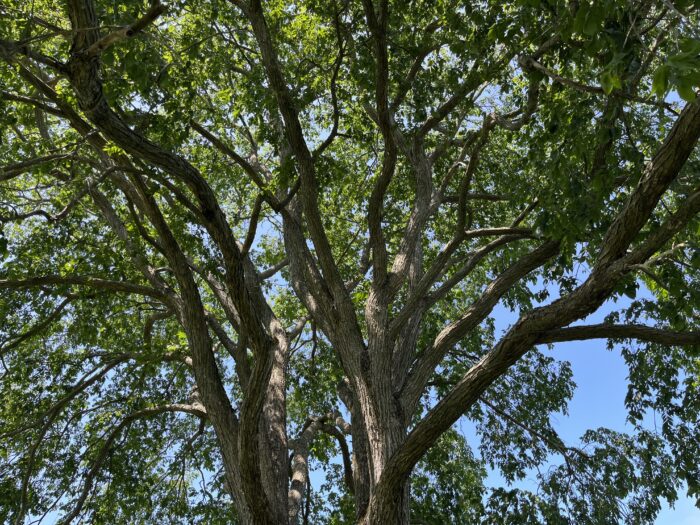
Scarborough Land Trust’s Pleasant Hill Preserve sits quietly among the town’s most popular outdoor recreation sites. One of its most intriguing features hides in plain sight.
Watching over the entryway of Pleasant Hill Preserve’s trail system, a lone American Elm tree (Ulmus americana) welcomes each visitor with its far-reaching limbs and stories of Scarborough’s history. Taking to the trails to walk a dog or find a quiet space outdoors, many people stroll past the old elm without much thought. Perhaps its grandiose height or its yellow-gold leaves in autumn warrant a second glance or a photo, but few listen to the stories this elm has to share.
Standing 50 feet tall, Pleasant Hill Preserve’s elm has held its position here for an estimated 200 years. The Emerson Elm – named for the generosity of Fred Emerson – watched as the old farm property was tended by four different families between 1826 and 2005 to raise hay, vegetables, horses, and cattle. Most staggering about the tree is the fact that it still stands tall.
Native to the eastern half of the United States, the popularity of American Elms flourished in the nineteenth and early twentieth centuries as the country saw rapid urbanization and increased development of even small towns. Favored for their quick growth, visually pleasing shape, and the shade and windbreaks their limbs offered, American Elms earned the title of one of America’s favorite street trees.
Perhaps foreshadowed by the use of the past tense, American Elms met their match in the late 1920s with the introduction of Dutch Elm Disease to North America. Thought to be transported in a shipment of elm logs from Europe to a furniture maker in Ohio, Dutch Elm Disease wreaked havoc on American Elms. Hidden within the furniture-destined lumber lived the fungus Ophiostoma ulmi which, when unknowingly transported by Elm Bark Beetles, traveled from one live tree to the next through the elm’s entire range.
Nearly 100 years since the introduction of the pathogen to North America, the Emerson Elm’s natural resistance to Dutch Elm Disease paired with vaccination against the fungus means that it lives on at Pleasant Hill Preserve. Living its first 100 years facing few viral threats, the Emerson Elm’s germination likely coincided with the admittance of Maine to the United States. The old tree watched from a distance through the Civil War, has seen the coming and going of more than forty American Presidents, and felt the remodeling of American landscapes, all while Scarborough’s population increased by a multiple of eleven.
Today, Pleasant Hill Preserve’s Emerson Elm rests on land permanently conserved by the Scarborough Land Trust. Productive vegetable patches and grazing pastures have been regenerated as woods, wetlands, and meadows in service of recreation and wildlife protection. The history of the land, the town, the state, and the country cycle through the elm’s resilient cells, and if you have the patience to listen, it might just share its stories with you.
Image and writing: Henry Gustavson, Education and Communications Specialist
For further reading, please visit:
https://ufi.ca.uky.edu/treetalk/ecobot-american-elm
https://www.fs.usda.gov/Internet/FSE_DOCUMENTS/stelprdb5342693.pdf
https://scarboroughlandtrust.org/wp-content/uploads/2017/01/PHP_Farming_Heritage.pdf


